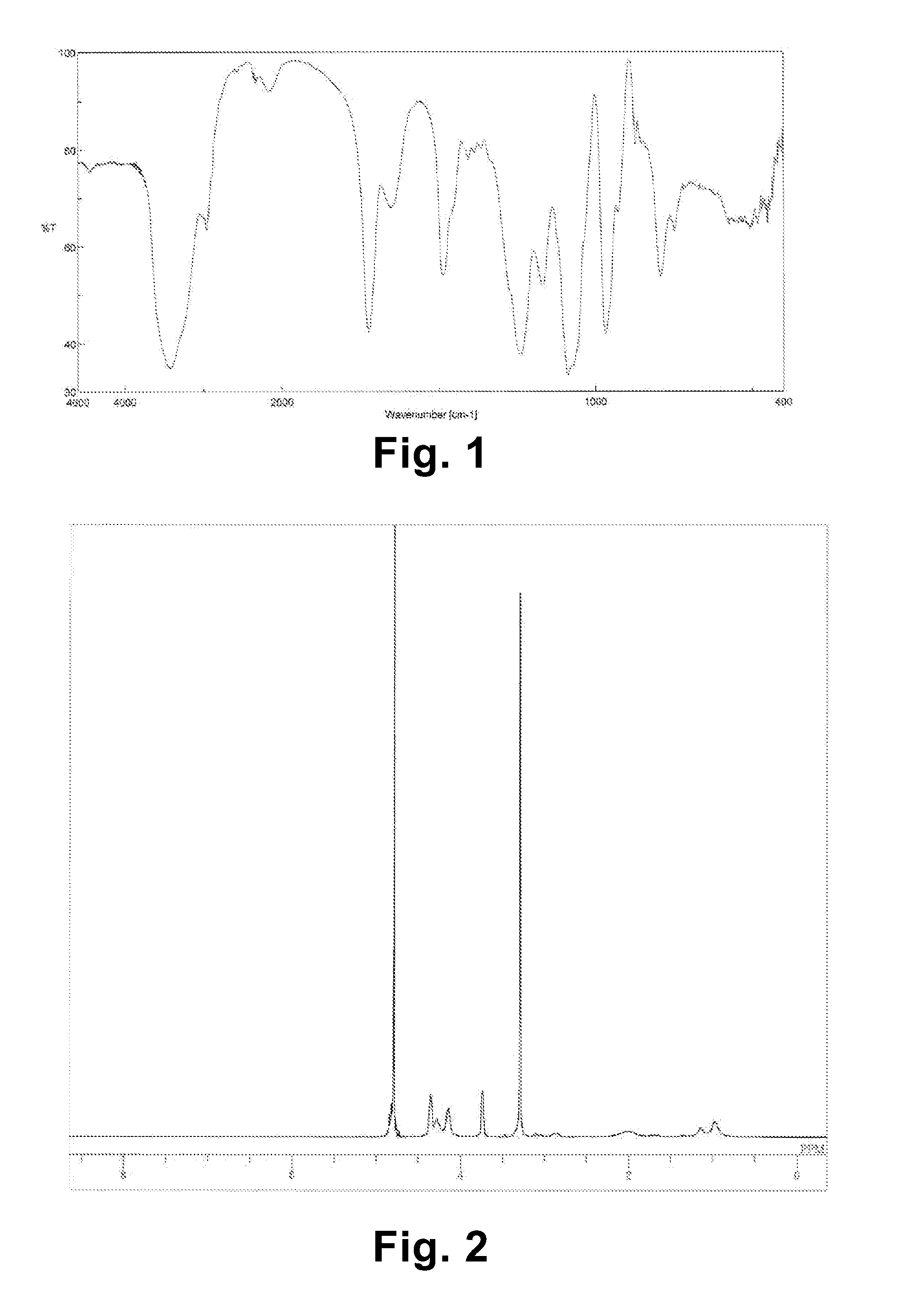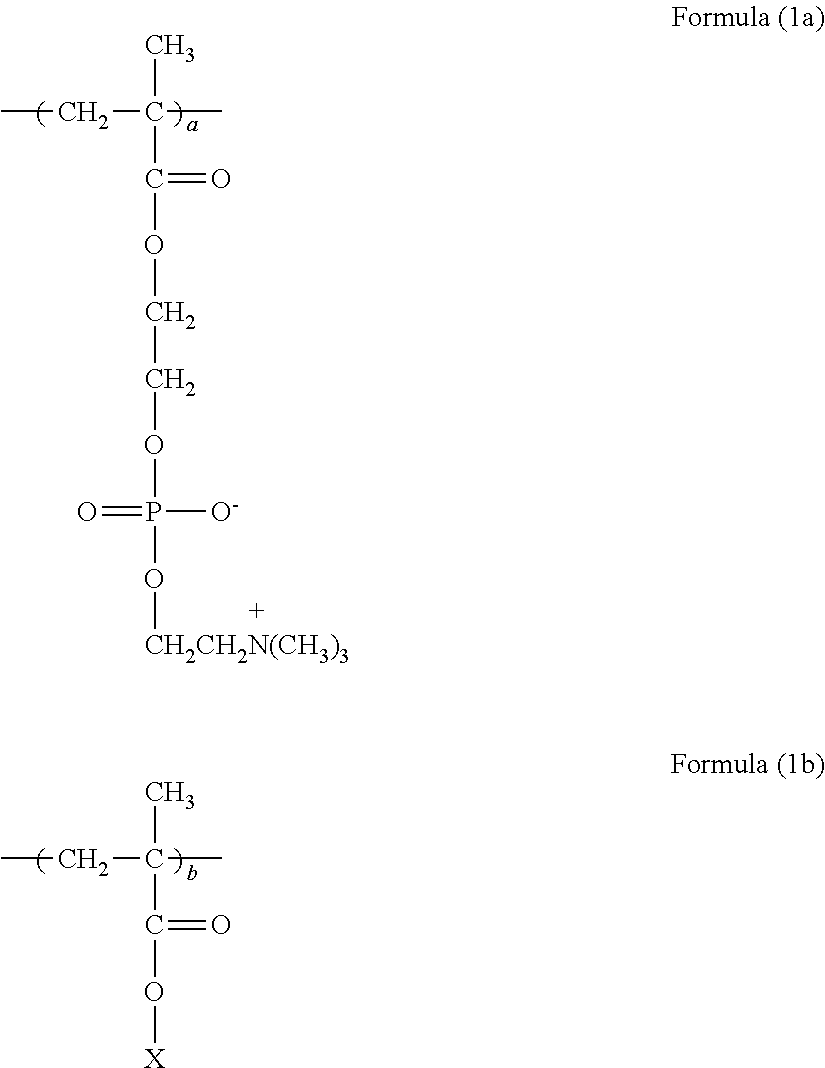Polymer and method for producing same
a polymer and polymer technology, applied in the direction of coatings, etc., can solve the problems of deterioration of biocompatibility, high toxicity, inconvenient handling, etc., and achieve the effects of reducing cytotoxicity, simple processing, and reducing toxicity
- Summary
- Abstract
- Description
- Claims
- Application Information
AI Technical Summary
Benefits of technology
Problems solved by technology
Method used
Image
Examples
example 1-1
[0084]68.3 g of MPC (manufactured by NOF CORPORATION) and 1.7 g of GMA (manufactured by NOF CORPORATION) were dissolved in 210.0 g of n-propanol (NPA, manufactured by KISHIDA CHEMICAL CO., LTD.), placed in a 500 mL four-neck flask equipped with a thermometer and a cooling tube, and blown with nitrogen for 30 minutes. Then 0.27 g of t-butyl peroxyneodecanoate (PB-ND, manufactured by NOF CORPORATION) was added at 60° C., and polymerized for 8 hours. The chemical structure of the obtained polymer was confirmed by IR and 1H NMR. Next, to 280.0 g of this polymer solution (solution of the polymer represented by formula (2)) was added 157.5 g of NPA, and mixed into a uniform mixture. In this mixture, 9.8 g of AET (manufactured by WAKO PURE CHEMICAL INDUSTRIES, LTD.) was dissolved, heated, and stirred at 74° C. for 12 hours. When the reaction was completed, the resulting mixture was subjected to dialytic purification and freeze drying to recover white powdery polymer. The obtained polymer w...
example 1-2
[0088]66.4 g of MPC, 3.6 g of GMA, and 163.3 g of NPA were placed in a 500 mL four-neck flask equipped with a thermometer and a cooling tube, and blown with nitrogen for 30 minutes. Then 0.23 g of PB-ND was added at 60° C., and polymerized for 8 hours. The chemical structure of the obtained polymer was confirmed by IR and 1H NMR. Next, to 233.3 g of this polymer solution (solution of the polymer represented by formula (2)) was added 204.2 g of NPA, and mixed into a uniform mixture. In this mixture, 19.6 g of AET was dissolved, heated, and stirred at 74° C. for 12 hours. When the reaction was completed, the resulting mixture was subjected to dialytic purification and freeze drying to recover white powdery polymer. The obtained polymer was subjected to the measurements in the same way as in Example 1-1. The results are shown below and in Table 1.
[0089]IR: 3425 cm−1 (—OH), 2961 cm−1 (—CH), 1724 cm−1 (C═O), 1489 cm−1 (—CH), 1241 cm−1 (P═O), 1170 cm−1 (C—O—C), 1089 cm−1 (P—O—C), 968 cm−1...
example 1-3
[0092]62.5 g of MPC, 7.5 g of GMA, and 210.0 g of NPA were placed in a 500 mL four-neck flask equipped with a thermometer and a cooing tube, and blown with nitrogen for 30 minutes. Then 0.27 g of PB-ND was added at 60° C., and polymerized for 8 hours. The chemical structure of the obtained polymer was confirmed by IR and 1H NMR. Next, to 280.0 g of this polymer solution (solution of the polymer represented by formula (2)) was added 157.5 g of NPA, and mixed into a uniform mixture. In this mixture, 39.3 g of AFT was dissolved, heated, and stirred at 74° C. for 12 hours. When the reaction was completed, the resulting mixture was subjected to dialytic purification and freeze drying to recover white powdery polymer. The obtained polymer was subjected to the measurements in the same way as in Example 1-1. The results are shown below and in Table 1.
[0093]IR: 3425 cm−1 (—OH), 2961 cm−1 (—CH), 1724 cm−1 (C═O), 1489 cm−1 (—CH), 1241 cm−1 (P═O), 1170 cm−1 (C—O—C), 1089 cm−1 (P—O—C), 968 cm−1 ...
PUM
| Property | Measurement | Unit |
|---|---|---|
| mass % | aaaaa | aaaaa |
| molar ratio | aaaaa | aaaaa |
| molar ratio | aaaaa | aaaaa |
Abstract
Description
Claims
Application Information
 Login to View More
Login to View More - R&D
- Intellectual Property
- Life Sciences
- Materials
- Tech Scout
- Unparalleled Data Quality
- Higher Quality Content
- 60% Fewer Hallucinations
Browse by: Latest US Patents, China's latest patents, Technical Efficacy Thesaurus, Application Domain, Technology Topic, Popular Technical Reports.
© 2025 PatSnap. All rights reserved.Legal|Privacy policy|Modern Slavery Act Transparency Statement|Sitemap|About US| Contact US: help@patsnap.com



